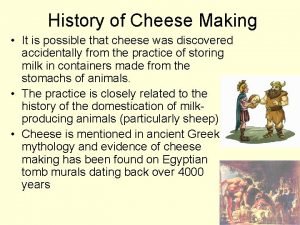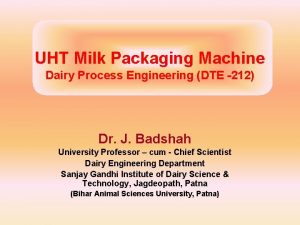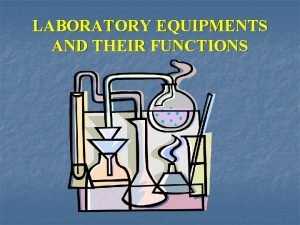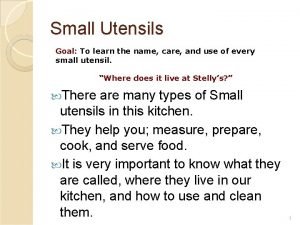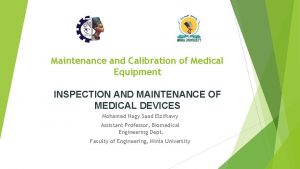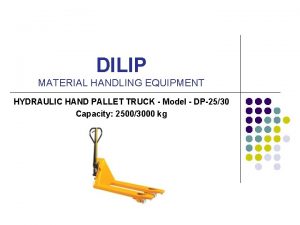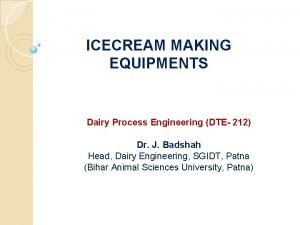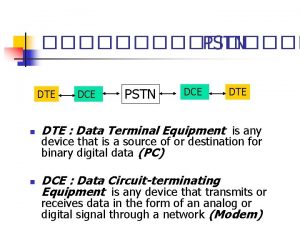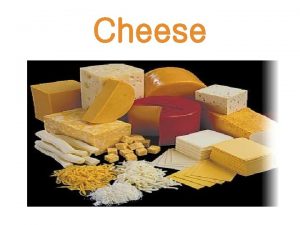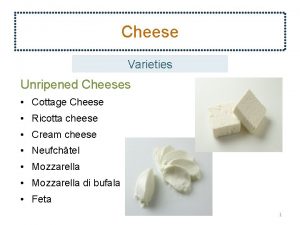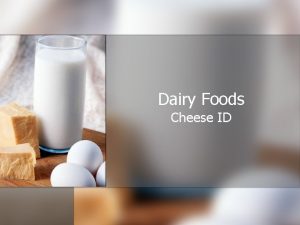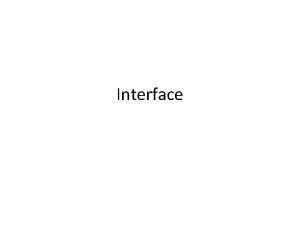Cheese Making Equipments Dairy Process Engineering DTE 212












- Slides: 12

Cheese Making Equipments Dairy Process Engineering (DTE -212) Dr. J. Badshah University Professor – cum - Chief Scientist Dairy Engineering Department Sanjay Gandhi Institute of Dairy Science & Technology, Jagdeopath, Patna (Bihar Animal Sciences University, Patna)

The traditional process of cheese making 1. Standardization of milk : Generally fat to casein ratio = 1: 0. 68 to 1: 0. 7 2. Clarification and Pasteurization : 72°C for 15 seconds 3. Homogenization of milk: It helps in greater access of lipase enzyme to fat, allowing faster fat hydrolysis necessary to secure blue cheese flavour, wherever necessary 4. Ripening of milk: Stored in cheese vat at 31°C and add good active bulk starter culture @ 0. 5 to 1. 5 % of volume of milk. Maintain 31°C till the increase in acidity upto 0. 02 %. Add colour if needed @ 0. 01 % of milk by diluting colour with water @ 5 times of its volume. 5. Formation of coagulum: Add rennet @ 165 ml/1000 kg milk in about 30 min and check the coagulum by dipping bulb of thermameter, which comes with clean cleavage.

The traditional process of cheese making Ø 6. Cutting of the curd and drainage of whey: Raising temperature of curd to 35 °C in about 30 min and holding for about 45 min to firm the curd and removal of whey. Careful cutting of the curd into uniform size to promote whey removal. Dipping or whey drainage and retaining maximum solids. Ø 7. Cheddaring : It is a characteristic step for cheddar cheese, by cutting the curd into slabs, turning every 15 min and piling every 30 min to get 3 to 4 high piles of curd to develop proper body in the curd when acidity of whey is 0. 5% lactic acid (p. H about 5. 2). Ø 8. Milling the curd: It mills into pieces to help in filling into hoops for pressing. Ø 9. Salting: It is required to get about 1. 5% of salt in finished cheese for flavour development and stoppage of acid production.

The traditional process of cheese making Ø 10. Pressing: Hoops are pressed for about 12 to 16 h for removal of whey and getting final desired moisture content in cheese, and cheese blocks waxed to cover external surfaces. Ø 11. Drying, Parafining and Curing: Curing under controlled conditions of temperature and humidity to develop characteristic body and flavour in cheese.

Cheese making Equipments in traditional Methods Ø Cheese vat: The cheese vat used for coagulation and cooking are made of either SS or with SS lining rectangular design. The vats are jacketed, allowing space for circulation of water between the inner and outer container. The inner tank should not have any sharp corners and the welded joints should be properly ground and polished for effective cleaning. Ø Agitator : The agitator is used for moving the curd after cutting, fork type motor driven agitator which reciprocates back and forth from one end of the vat to the other end Ø Cheese knives: For bringing uniformity in size of pieces, two kinds of knives are used. One knife cuts the curd into horizontal layers and the other vertically across these layers from top to bottom, slicing them into small cubes. •

Cheese making Equipments in traditional Methods Ø Gate Strainer: Whey is removed from the vat through a gate strainer which holds back the curd. It is semicircular in design with perforation which can be fitted to the vat outlet. Ø Curd mill: The mill, spike-toothed or circular blade type, cuts the curd into small pieces of uniform size and should do it without crushing or squeezing the milk fat from the curd. The mill could be hand operated or motor driven. Ø Cheese hoops: Different designs and capacities of hoops are available, to give shape to the curd and compact the same. They are round or rectangular (Wilson type) with followers. Ø Cheese press: The cheese press is used to press the cheese in the hoops. The loaded cheese hoops are placed in the press and pressure applied. The hoops should not be of bulging or buckling type so that uniform pressure is developed.

Processed Cheese Ø Grinder and miller for Processed cheese: Chopper or Mixer fitted with knife edged worn screws rotating in opposite direction and then extended through small opening eg. A perforated disc. Mill consists of three rollers, each rotating at different speeds i. e. 50, 100 & 200 rpm with scraper at outlet roller and feed at first roller. Ø Conveyor Belt Cooler for Processed Cheese: Low moisture and warm grounded mass of processed cheese is spread in a thin film on a metal conveyor belt cooled from below with spray jets of cooled water. By means of scraper , the film is transferred to the next cooling conveyor belt so that the cheese slices are cooled from both sides. On discharge sides, the processed cheese is sliced into band stacked and then cut into appropriate length.

Mechanization in Cheese Making Ø Purpose: a. To reduce the cost of manufacture, b. To Increase the productivity c. To improve working condition and safety d. To avoid manual labour and adopt the automation and machines e. To increase handling capacity from 2, 50, 000 to 10, 000 litres per day. f. To cut the coagulum and handle the curd with large volume of milk at economical cost

Mechanization in the major stages of cheese making Ø Curd Making: i. Use of banks of rectangular jacketed cheese vats of about 15000 l capacity using built in swinging stirring units to stir curd-whey mixture ii. Mechanical cutting is now widely used and nylon thread is replacing SS wire in many cases. iii. Vats are fitted with pneumatic or hydraulic tilting gears for emptying the contents. Ø Curd/whey separation and texturing of curd: i. Troughs with perforated linings, vibrating mesh separator to separate fine particles of curd from whey, rotating screens or simple screens. ii. The curd conditioning by (a) pumping or gravity flow of curd/whey mixture, (b) transfer of curd pieces by vibrating belt or conveyor belt. iii. The stretching and squeezing are affected by belts running at different speeds

Mechanization in the major stages of cheese making Ø The curd is converted into fibrous slab in cheddar towers where the curd is forced down by the pressure of the succeeding curd into a square bottom cross section, or in a cheddar box with regular turning through 900 every 15 min. milled, salted and filled in moulds and carried on long moving belts. Ø The milling of cheddar curd is done by power driven mill and the use of block shaped perforated SS or light noncorrodible plastic moulds. The feeding of the milled curd is done by vibrations, and automatic weighing machine.

Hooping, Moulding and Pressing Ø The pneumatic, hydraulic or mechanical spring press has replaced the lever type of presses. Ø The demand of close textured cheese has led to the technique of vacuum pressing of cheese. This system sucks out air between the curd particles and eliminates open texture in cheese. Ø The press consists of a chamber of rectangular cross-section fitted with piston at the bottom for compression and extrusion of the pressed curd at the top. Ø The top removable lid can be replaced by cutters to get blocks. The height of the extruded curd is adjusted to get required size of the block. Ø Vacuum is applied on all the sides of the curd block (about 80 k. Pa). Ø This is followed after about 10 min, a pre-pressing pressure of about 3, 400 k. Pa for 10 min, raised to about 9, 500 k. Pa leads to a final pressure of 480 k. Pa on the cheese. The press time varies. Normally, it is 1. 5 h under vacuum and 6. 5 h under normal pressure

 Flow chart of cheese production
Flow chart of cheese production Cheese making process diagram
Cheese making process diagram Cheese making process
Cheese making process Cheese making process
Cheese making process Dairy process engineering
Dairy process engineering Ls strip tetra pak
Ls strip tetra pak Therapeutic equipments
Therapeutic equipments Glass stool
Glass stool Knives hand tools and small equipments
Knives hand tools and small equipments Medical equipment inspections
Medical equipment inspections Dilip lift truck
Dilip lift truck Condition monitoring of electrical equipments
Condition monitoring of electrical equipments Equipments needed in basketball
Equipments needed in basketball



